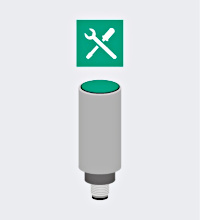Sensor Mounting

Below you will find an overview of the main points to consider when integrating magnetic field sensors into your applications.
Preparatory Measures
When selecting a sensor, first determine the industry type and application areas in which the sensor will be used.
It is important to select the sensor according to the installation options and the required detection range. For planning purposes, take this information into account and clarify the installation conditions. Determine the operating distances required.
It should also be specified whether the sensor can meet special conditions and, if so, what conditions. Find out which sensors are suitable for the ambient conditions of your application and find out the relevant suitability for use.
More information:
Applications and Industries
Suitability for Use
Ambient Conditions
Work Steps in Detail
The basic procedure for mounting a magnetic field sensor is as follows:
1. Checking and Selecting Installation Conditions
Due to the passive nature of magnetic field sensors, the type of installation is of minor importance, unlike with induc-tive or capacitive sensors. The type of installation or structure of the damping magnets is important. When flush mounting the damping magnet on a magnetically conductive material, the operating distance of the sensor can be significantly reduced. However, if a magnet is not flush mounted on a magnetically conductive material, the operating distance of the sensor can increase slightly.
More information:
2. Determining/Monitoring Operating Distances with the Damping Magnet
Each magnetic field sensor has a specific detection range and operating distance.
Due to the individual mounting situation in the specific application, it must be ensured that the sensor with the existing damping magnet reliably achieves the required detection range.
More information:
Determining the Operating Distances
3. Single-Hole Mounting or Surface Mounting of the Sensor
Cylindrical Sensors
Cylindrical sensors are small and have an external thread that allows simple and space-saving mounting of this sensor type. They are available in different diameters.
For single-hole mounting of cylindrical sensors with metal housings, the tightening torques for the external threads or the fastening screws must be observed.
The tightening torques required to mount sensors with corresponding fastening screws depend on the diameter and material of the sensors.
The following table provides an overview of conventional diameters and materials.
| Thread diameter | Stainless steel | Brass | PBT | PPS |
|---|---|---|---|---|
| M5 x 0.5 | 3.0 | - | - | - |
| M8 x 1 | 10.0 | 3.0 | - | - |
| M12 x 1 | 15.0 | 10.0 | 0.75 | - |
| M18 x 1 | 30.0 | 30.0 | 1.5 | 5 |
| M30 x 1.5 | 30.0 | 30.0 | 3.0 | 10 |
Tightening torques [Nm]
Cubic Sensors
Cubic sensors are designed such that they can be easily and quickly mounted on surfaces at the required location. Depending on the housing design, they have one or more mounting holes with threads for fastening with corresponding screws.
4. Connection to Voltage Supply and Control Inputs
The exact way in which the electrical connection is established depends on which sensor is selected. The connection options vary depending on the type of connection. Accordingly, the information relating to the particular connection type must be observed.
More information:
Connecting Magnetic Field Sensors
5. Checking the Operating State and Switch State
Finally, the operating state and switch state of the sensor with damping magnet must be checked.









 +49 621 776-0
+49 621 776-0